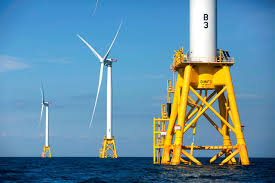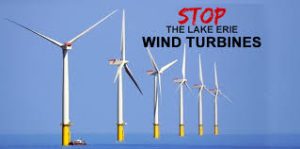
Oklahomans are used to see the state’s vast horizon broken by wind-generating turbines, but none are in the lakes and waters of the state. However the nation’s first fresh-water wind farm has won approval in the state of Ohio where one is planned to be located in Lake Erie near Cleveland.
But as electrek reported, there is a big “if.” And the project doesn’t come without its opponents.
Lake Erie Energy Development Corp. (LEEDCo), a Cleveland-based public-private partnership, is developing the freshwater offshore wind farm project with partner and investor Fred. Olsen Renewables of Norway. Icebreaker has been a decade in the making.
The plan controversially stipulates that the farm must cease operations between March and October to protect birds and bats due to it being located in an “Important Bird and Biodiversity Area.” LEEDCo is concerned that the lengthy downtime could defeat the project.
The American Bird Conservancy and the Black Swamp Bird Observatory wanted the project stopped, citing location, but the Sierra Club felt that limitations on when the wind farm can operate are too restrictive. Public comments were evenly split between those for and against the project.

Further, now bankrupt fossil-fuel company Murray Energy Corp. brazenly stated in January 2019 that they openly fought the Icebreaker project:
“Murray Energy is pleased that its outside counsel… can assist the Bratenahl residents to prevent Icebreaker from steam-rolling this project through the Ohio Power Siting Board certification process without the public scrutiny and opposition that it deserves.”
Icebreaker was competition for coal, but Murray is finished.
David P. Karpinski, president of LEEDCo, which is planning and developing Icebreaker Wind, is concerned the cease of operations could put the whole project in jeopardy, and put out a statement on May 21:
“We made it abundantly clear that a requirement to shut down the turbines from dusk to dawn for the majority of the year renders the project economically not viable. LEEDCo has invested incredible amounts of time and money into studying and assessing potential impact to birds and bats. We have not taken it lightly.”
Consider just the following:
- The U.S. Department of Energy ruled — after an intensive two-year study — that Icebreaker will have no significant impact on the environment.
- Icebreaker has been endorsed by environmental groups, including the Sierra Club, the Environmental Defense Fund, and the Ohio Environmental Council.
- Icebreaker has earned approvals from regulatory agencies including the Ohio Environmental Protection Agency, the US Army Corps of Engineers and the US Fish and Wildlife Service. The project had been thoroughly reviewed for many years under the strictest of environmental regulations and reviews by 13 local, state and federal agencies.
“In light of today’s decision, LEEDCo will need to reconvene in the coming days and examine our options on how and whether we can move forward.”
E&E News explains the project’s planned specs:
The 20.7-megawatt Icebreaker project is planned for 8 to 10 miles off the Lake Erie shore and will be connected by an underwater cable to a Cleveland Public Power substation.
It is partially funded through Department of Energy grants and involves six turbines rising almost 500 feet above the lake that would generate about 75,000 megawatt-hours of energy per year to be sold into the grid operated by PJM Interconnection LLC.
The wind farm might be online by 2022, provided it can proceed. Turbines will also need to be able to withstand ice floes in the winter.
Source: electrek






